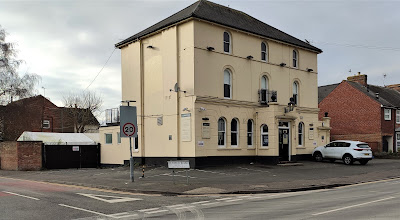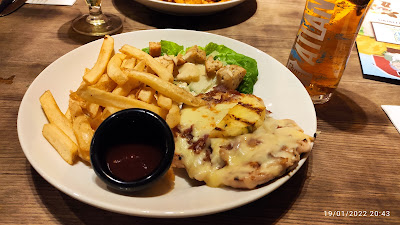I realised I haven’t posted anything since last weekend, although that’s not strictly true, as I’ve been working on an article for my website. "Regensburg – pearl of the Danube," was part of the slightly cheesy title, even though this UNESCO World Heritage site is anything but cheesy.
If you are looking for somewhere for your next holiday – once travel gets back to normal, that is off the beaten track, that combines a beautiful and well-preserved medieval city, in a stunning location with some first-class beer, then click the link. Otherwise, please read on.
Since last Friday week, I’ve visited six different pubs, in six separate locations, and whilst this tally is probably all in a day’s work for seasoned pub people and serious GBG tickers, it’s quite an achievement for me, coming as it does as the country begins to shake of the shackles of Covid-19 restrictions.

My destination in Rolvenden was the Bull Inn, one of two pubs in the village, the other being the Star. I hadn’t been in either, so the bus allowed the perfect opportunity to rectify one of those omissions. This time around it had to be just one, as the bus timings only allowed 30 minutes pub time, before the return service that would drop me at another Bull, where I had planned a longer session. (More of that in a minute).
So, the Bull Inn it was, and as the bus had, rather conveniently, dropped me right outside the pub, it would have been churlish not to have ventured inside. The first thing I noticed was there were two bars. I could tell this from the outside, due to the large, plain glass windows, fronting the pub on either side of the door, and for no particular reason I chose the left hand one.
As I walked in, there was a customer sitting in the window seat, nurturing his pint whilst, at the far end of the bar, and at a slightly lower level, I noticed a couple sitting around the rather cosy-looking log burner. They’d gone, by the time I took the photo, but sidling up to the bar, and ignoring the two “T”- bars dispensing both faux and genuine craft, lager, and ciders, I ordered myself a pint of Harvey’s Sussex Best – the only cask offering available. The barmaid had some difficulty in pulling my pint, as the pump was making that splurging sort of noise that is a sure sign the cask is on the verge of running out. I made a remark to that effect, and she agreed, so when the chap who’d been siting in the window came up and requested another pint of Harvey’s, she mentioned about popping down to the cellar, to check things out. I took my pint across to an empty table, in front of the side window, and started drinking it – conscious that I only had half an hour to do so. It seemed OK at first, but after a couple more mouthfuls, I realised it was definitely off.By this time the girl had enlisted the help of a young lad, and between them they were pulling the fresh pint through. I didn’t have to say anything, and my “end of the cask” pint was replaced without question. Full marks to the bar staff here, and I sat back down to enjoy my pint. A family that had booked for lunch, entered via the rear car park, and were shown through to the other bar, which is obviously the one for posh nosh/fine dining. I just had time to finish my pint, thank the girl behind the bar, and cross the road to the bus stop opposite. I was able to get some good photos of the pub exterior, before the bus turned up – the same double-decked vehicle I’d arrived on earlier. I boarded, and with only one stop to go, sat downstairs. I must say, sitting on the upper deck on the outward journey, had seemed a little hair raising at times, as the driver put his foot down, trying to make up for the earlier hold-up we’d encountered in Pembury, caused by a narrow road and a bin-lorry doing the weekly collections. I do wonder who routes buses that are more suitable to urban environments, through residential areas where the roads are clogged with inappropriately parked cars.
There wasn’t far to go, as we approached the larger village of Benenden, where on the edge of the green, the second Bull Inn of the day stands, ready to welcome customers. I’d already clocked the pub as we passed through on the outward-bound journey, and it was only a short hop from the bus stop to the pub, but before I’d left the bus, I recognised the person coming down from the upper deck. Before I’d had the chance to acknowledge me, he was off the bus like a shot, and making his way towards the pub entrance. I hung back a while, primarily to take a few photos of the exterior, but after I’d entered the Bull and made my way into the left-hand bar, I could see no sign of this individual.
He soon appeared, having first visited the Gents and laid claim to a table. He was no less than Jeff Tucker, former chairman of MMK CAMRA, tour-guide extraordinaire and an old friend who I have known for many years. He was as surprised to see me standing at the bar, as I was to see him disappearing off the bus – or perhaps not, because Jeff is both a former bus driver and something of a public transport guru. His reason for visiting the Bull at Benenden was to carry out a survey for the Good Beer Guide and yes, I am talking about the 2023 edition! So, despite being just a month into the new year, CAMRA branches are already pontificating over next year’s guide, proving that by the time the GBG hit’s the bookshops in time for the all-important Christmas trade, much of the information will already be six months out of date.
The survey didn’t take long, as Jeff had printed off a list of questions, all of which the bar staff were able to answer. Between us we “tested” three of the beers – Dark Star Hophead, Larkin’s Traditional, and Cellar Head Flapjack Oatmeal Stout, and all passed muster! The pub was starting to fill up quite quickly, so it was fortunate that Jeff had managed to secure a table, tucked away on the other side of the bar.
We spent the time catching up on things, some CAMRA related, like the annual Good Friday Ramble, others less so, although I did have to explain why I was unable to make Jeff’s trip to Pilsen, this coming May. The trip had originally been scheduled for May 2020, but due to the pandemic had been scheduled and then postponed on a further two occasions. Unfortunately, the trip now clashes with the Baltic cruise that Mrs PBT’s and I have booked for late April-early May.
I was feeling hungry by this point and fancied something to eat. I like to have something solid, when I am drinking at lunchtime, such as a roll or a sandwich, but the Bull’s menu only offered “Light Bites & Starters” or mains. Soup would have been ideal, but with the day’s choice being tomato, I opted instead for a prawn cocktail starter, with brown bread and butter. No ideal, but it filled a hole, as they say. Jeff stayed with his “liquid lunch,” and said he would be catching the same 14.14 bus as me, and then alighting at Cranbrook in order to visit Larkin’s Alehouse – a micro pub, which despite its name, has no connection with Larkin’s Brewery.He asked if I’d care to join him, but I had to decline due to an errand I’d promised to fulfill for Mrs PBT’s. This involved picking up a fluorescent light tube, in Tonbridge, to replace the failed one in the kitchen. Failing to do this would mean her cooking under reduced light that evening, so being the dutiful husband, I thought it wise to comply.
Before leaving the Bull, I remarked to the barmaid as to how busy the pub was. She said they weren’t expecting such a crowd but were obviously surprised and pleased with the numbers. Perhaps this is the start of the long-awaited recovery in hospitality?
Jeff and I then boarded the bus, and before he got off at Cranbrook, he pointed out Larkin’s Alehouse to me. He chuckled and asked would my bladder last all the way back to Tunbridge Wells? I said it would, but by the time the bus reached Goudhurst, I was beginning to have my doubts. I decided I’d have to get off in Matfield, visit the strangely named Poet, next to the bus stop, and make use of their facilities.
I would obviously have a beer as well,
and Matfield was a good place to break my journey, as the No.6 bus passes through, much more frequently than the 297. This meant I could travel back to Tunbridge Wells, or journey in the opposite direction to Paddock Wood, and the train back to Tonbridge. The Gents at the Poet was on the small side, with just one urinal and one closet. Fortunately, neither were occupied, so feeling much relived I approached the bar and ordered a swift half.Despite the choice of Harvey’s or Cellar Head, I opted for a cool, refreshing and palate-cleansing glass of Pilsner Urquell – my favourite lager and a beer that’s rarely seen on draft in this neck of the woods. It was in good form, which was proof of good turnover, because even keg lagers can become stale, if kept for too long.
I took an instant liking to the Poet, not having been in there before – certainly
not under its present guise. I’ve a feeling I might have been in several decades ago, when this ex-Watney’s pub was known as Standing’s Cross, but there was nothing I could relate to from that time. The Poet at Matfield, to give the pub its proper name, offers an "informal yet refined dining experience," and whilst the menu prices seemed mouth-wateringly high, it still seemed a pleasant enough place to stop by and have a drink. The welcome I received from the staff was sufficient to encourage my return, and that, gentle readers, is the mark of a good pub.










































